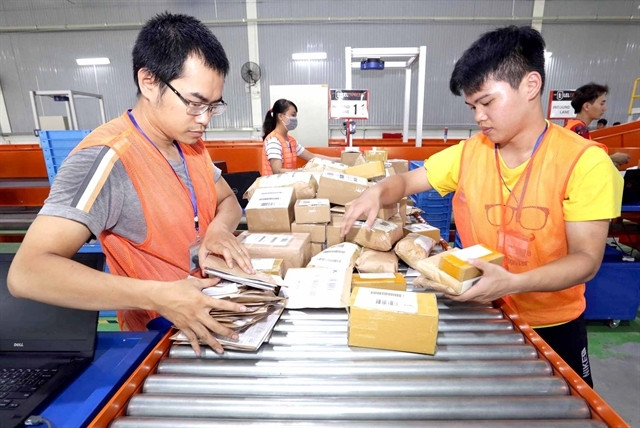 |
| Parcels being classified. Along with the boom of e-commerce in Việt Nam which is forecast to see another increase of 45 per cent in revenue this year, cheap imported goods are flooding into the Vietnamese market. — VNA/VNS Photo Trần Việt |
The Ministry of Planning and Investment reported that China is the largest import market of Việt Nam, with an import value of US$79.2 billion in the first seven months of this year, a rise of 34.9 per cent over the same period last year and accounting for 37.2 per cent of Việt Nam’s total import value.
The influx of cheap Chinese goods is significantly weighing on domestic production.
A report by HCM City Business Association showed that the number of firms reporting drops in revenue increased by 30.4 per cent in the second quarter of this year, while the inventory volume rose by 34 per cent and total outstanding loans rose by 42 per cent.
The association said that the figures demonstrated problems for the market, showing it was more difficult for enterprises to sell goods than ever before.
The boom of e-commerce in Việt Nam is forecast to see an increase of 45 per cent in revenue this year with cheap Chinese goods being flooding into the Vietnamese market. International stores are more popular on e-commerce platforms.
Goods from China are being sold at lower prices and even have faster delivery times, thanks to a developed logistics system.
According to the Trade Promotion Centre for Agriculture under the Ministry of Industry and Trade (MoIT), cross-border e-commerce trade is taking place robustly, but it seems to be one way. It is seemingly easy for international traders to sell on e-commerce platforms into Việt Nam, while Vietnamese sellers are still struggling to sell abroad.
What to do?
Professor Lê Văn Cường from the Paris School of Economics was quoted by Diễn Đàn Doanh Nghiệp (Business Forum) newspaper as saying that influx of cheap Chinese goods is a critical issue. The US and the EU are facing similar problems, such as the flooding of cheap Chinese electric vehicles in these markets.
Normally, countries will use taxes and quotas to deal with the influx of cheap imported products, such as anti-dumping duties to support local production and build technical barriers.
In addition, it is necessary to improve the logistics infrastructure system and modernise the supply chains, as well as to raise policies to encourage domestic producers to renovate, invest in research and development and build brands.
Việt Nam needs a long-term strategy that will improve human resource quality, improve production technology and productivity, he said.
For a specific industry, it is necessary for Việt Nam to have policies to climb higher in the value chain, not only simply by lowering prices to compete, he stressed.
According to the MoIT's Domestic Market Department, one solution is to promote domestic consumption for Made-in-Việt Nam products in the remaining months of this year.
The department also said that the legal system also needed to be improved further including new regulations on trade defence to protect domestic production and the local market in line with international commitments.
The efforts of the MoIT will strengthen the enforcement of the Law on Competition to create a fair and healthy business environment for enterprises, together with strengthening the implementation of the domestic trade strategy and programmes.
Nguyễn Cao Ngọc Dung from NeilsenIQ said that Vietnamese enterprises need to develop more efficient retail strategies in term of selling points, product quality, pricing and displays to attract buyers and to compete.
Phạm Hồng Sơn, an expert on e-commerce and digital transformation, said that Vietnamese enterprises should develop a combination of distribution channels, both online and physical, to optimise competitive advantages and develop brands. They should not be dependent on a single retail channel, he said.
Phạm Duy Hưng from Amazon Global Selling Vietnam said that attention must be paid to improving product quality, as well as on building brands towards long-term business development.
According to Nguyễn Xuân Hùng from the Việt Nam Logistics Association, Việt Nam should invest strongly in logistics system, together with focusing on standardising production and operation processes and encouraging enterprises to apply technology to optimise supply chains.
Việt Nam is seeking to impose value added tax (VAT) on goods worth equal to or less than VNĐ1 million ($39) imported via e-commerce platforms such as Shopee, Lazada and Tiktok.
The National Assembly’s Finance and Budget Committee estimated that between four and five million low-value orders are transported from China to Việt Nam via e-commerce platforms each day, amounting to $1.9 billion per month. — VNS